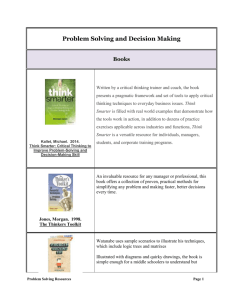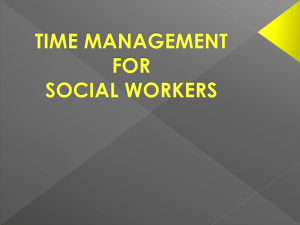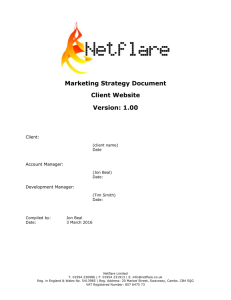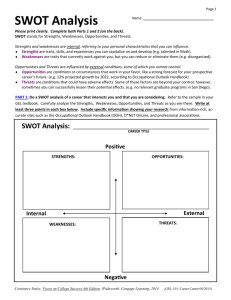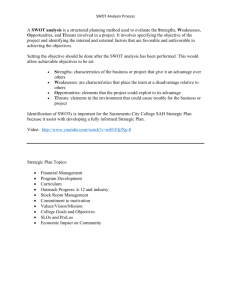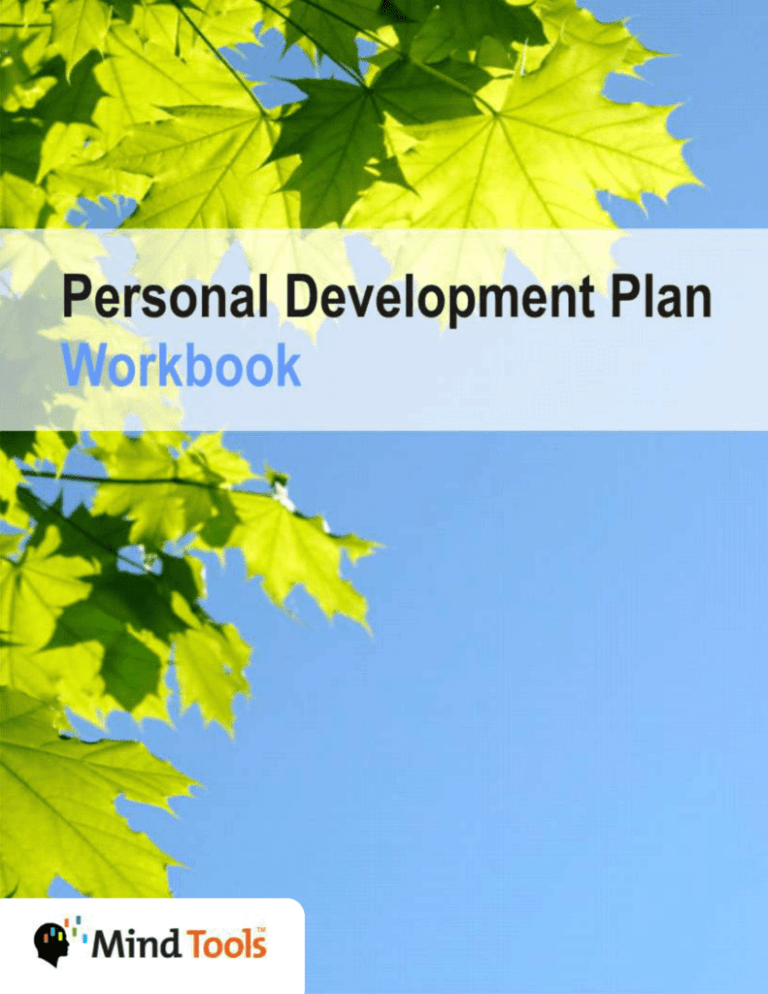
Personal Development Plan Workbook | www.mindtools.com
A newsletter subscriber bonus report, helping you better
motivate yourself and your team
© Mind Tools Ltd, 2007-2011.
1
Personal Development Plan Workbook | www.mindtools.com
Personal Development Plan Workbook
This e-book is published by Mind Tools Limited, of
2nd Floor, 145-157 St John St, London, EC1V 4PY.
Version 1.3
Copyright © Mind Tools Ltd, 2007-2011. All rights reserved.
This e-book is protected by international copyright law.
You may only use it if you have downloaded it directly
from the mindtools.com site, or if you have received it
under license from Mind Tools Ltd.
Cover image © iStockphoto/Petegar
© Mind Tools Ltd, 2007-2011.
2
Personal Development Plan Workbook | www.mindtools.com
Personal Development Plan Workbook
Introduced by Mind Tools CEO, James Manktelow
You have probably
come to Mind Tools
because you care
about your career,
and are prepared to
work at building a
happy, satisfying,
successful life.
Part of this involves
thinking about what
“satisfaction”
means to you: After all, we all get satisfaction
and happiness from different things. That‟s why
you need to think this through for yourself,
rather than just following someone else‟s preprepared plan.
Another part of this involves making sure that
when opportunities arise (as they will, if you
work hard and think about what you‟re doing)
you have the skills needed to take full
advantage of them.
and instructions, that you can use to plan how
you‟ll develop the skills you need for a satisfying
and successful career. Tools like SWOT and
PEST, and techniques like setting SMART
goals are all part of the process. Using these
resources and applying them to your personal
plan for continued development, you will come
away with a thoughtful and well-considered plan
that you can follow to reach your career goals.
Your Personal Development Plan comprises
seven basic steps. We‟ve split these steps into
these three sections:
Understand Yourself.
Define your Career Objectives.
Create Your Personal Development Plan.
Each section builds on the next, so I encourage
you to work through them in order.
I hope you enjoy this workbook, and find it
useful!
That‟s why it‟s important to take a systematic
approach to developing your skills, so that
they‟re ready when you need them. Developing
a Personal Development Plan is the starting
point for this.
This downloadable workbook guides you
through the process of creating your own
Personal Development Plan. Within it, you‟ll find
a step-by-step process, supported by templates
© Mind Tools Ltd, 2007-2011.
James Manktelow, CEO,
MindTools.com
3
Personal Development Plan Workbook | www.mindtools.com
Contents
Why a Personal Development Plan? .......................................................................................... 5
Understand Yourself ................................................................................................................... 6
Personal SWOT Worksheet ........................................................................................................ 8
Personal PEST Worksheet ....................................................................................................... 10
Opportunity Analysis Worksheet ............................................................................................... 12
Define your Career Objectives .................................................................................................. 13
Create your Personal Development Plan .................................................................................. 15
Have you found this e-book useful? .......................................................................................... 18
Personal Development Plan Worksheet ................................................................................... 19
© Mind Tools Ltd, 2007-2011.
4
Personal Development Plan Workbook | www.mindtools.com
Why a Personal Development Plan?
Are you fully in control of your career? Do you
have a clear and inspiring idea of what you want
to achieve in the future? And are you actively
taking steps to pursue the career of your
dreams?
If you are not, then you risk seeing your dreams
dashed. If you put the course of your career in
the hands of others – your organization, your
boss, your partner, or even (originally) your
parents – you risk not going where you want to
go, and not doing what you want to do. After all,
if you‟re not working to realize your own
dreams, you‟re most likely working to achieve
someone else‟s.
All too often, this abdication of career direction
happens without you even realizing it. See if
you recognize yourself in the following scenario:
Jim had been in his current position for three
years. His job was comfortable. He knew what
was expected of him, his boss was great, and
his teammates were his friends. Life was good.
Six more months passed and Jim started
watching the clock. The 4:00 countdown
became a daily ritual and by Wednesday, Jim
was in Friday mode. He started wanting more
excitement and challenge. The humdrum status
quo just wasn’t cutting it anymore. He needed
something to change right away!
promotion of some kind… maybe a job
reassignment… well, what about a change of
office at least?
Unfortunately for Jim, no one ever told him that
neither his company nor his boss was
responsible for his career satisfaction. No one
let him in on the secret that if you do the same
thing today as you did yesterday, the results for
tomorrow are likely to be no different.
You have to be proactive. You have to take
charge, and change the way you think about
your career. When you take back control, you
will realize that the only way you„ll achieve what
you want, personally or professionally, is to
think about where you want to go, put in place
a plan to get there, and then start moving.
Personal Development Planning is a structured
way of doing just that.
First, you understand yourself so you can
set meaningful goals.
Next, you define these goals in terms of
what you want to achieve and the steps
you need to get there.
Finally, you identify gaps in your skills and
experience and create an action plan that
will fill them in, so that you start to move
you closer and closer to your end goal.
So, let‟s start the process right now!
So, where were all the changes? Surely he’d
been at the place long enough to deserve a
© Mind Tools Ltd, 2007-2011.
5
Personal Development Plan Workbook | www.mindtools.com
Understand Yourself
Discover Who You Are and What You Want
Personal Development Planning is all about
creating a long term goal for your career, and
then planning how you‟ll get there.
However, before you can know what you want
to do in the long term, some serious reflection is
in order. What are you good at? What are you
not so good at? What opportunities are
available? And are there factors beyond your
control that could impact your goals?
To answer these questions, we‟ve adapted two
classic business tools, SWOT and PEST, so
that you can apply them to your personal
situation. Through these analyses you will gain
a solid understanding of where you are now,
and where you would be well suited to go with a
high chance of success.
Personal SWOT
In business, SWOT Analysis uncovers the
Strengths and Weakness of an organization,
and the Opportunities and Threats facing it. Just
as this is useful for organization, it‟s very
powerful when you apply it to your own
situation: By knowing your strengths, you can
focus your efforts on the things you‟re good at,
and by understanding your weaknesses, you
know what to avoid, what to improve, and where
to get help from people who do those things
better.
Taken
together,
your
strengths
and
opportunities help you to identify potential long
term career goals. Your weaknesses and the
threats you face are things that need to be
managed, mitigated, or planned for to ensure
your goals remain achievable.
To begin a Personal SWOT you ask yourself a
series of questions about your existing
circumstances and fill in a four-quadrant grid
like the one found on page 8. We explain these
quadrants below:
© Mind Tools Ltd, 2007-2011.
Strengths
The goal here is to uncover what sets you apart
from most other people. What do you and
others see as the qualities that make you stand
out?
When thinking about your strengths, don‟t limit
yourself to just work skills, think of all the
experiences you‟ve had, and the opportunities
you‟ve had to grow and develop. This includes
your education, aptitudes, personality factors,
and interests. Answer the following types of
questions to complete your strengths section:
What are you really good at?
What skills do other people recognize in
you?
What do you do better than most people
you work with?
What do you get recognized or rewarded
for?
What, about yourself, are you most proud
of or satisfied with?
What
experiences,
resources
or
connections do you have access to that
others don‟t?
Remember to ask your friends, peers and family
to give you ideas about your strengths as well.
We tend to be self-effacing and downplay our
own strengths, so this is a great way to get
more ideas. It‟s also a real boost to your selfesteem when you learn what others think you
do really well!
Weaknesses
Here you turn the tables and get real about the
things you are not so good at, or the areas
where you can improve your current
performance. We list our weaknesses so we
can reduce them or manage them, so they don‟t
stand in the way of our goal achievement.
When you do this, don‟t “beat yourself up” about
weaknesses: We all have them. The trick is to
recognize
them
and
manage
them
appropriately. Also, don‟t be too self-critical. If
6
Personal Development Plan Workbook | www.mindtools.com
you‟re fair and forgiving about other people‟s
weaknesses, make sure you forgive yourself
your own too.
To complete your Weaknesses section, use the
following questions as a guide:
What do you try to do that you just can‟t
seem to master?
What do you do only because you have to
in order to satisfy job requirements?
Are there one or two aspects of your
personality that hold you back?
What do other people most often identify
as a weakness for you?
Where are you vulnerable?
Where do you lack experience, resources
or connections where others have them?
Unlike the Strengths section, don‟t feel
compelled to list every weakness you can think
of. Limit yourself to the ones that can have an
impact on your career satisfaction.
Opportunities
Now that you have looked inside yourself, you
turn your attention to the outside and identify
elements that you can build on or take
advantage of that will improve your chances of
success. This is best done by setting aside
some time and brainstorming in an attempt to
uncover new and innovative ideas that may not
have occurred to you before.
In what ways can you maximize your
strengths?
What opportunities are open to those who
do these things well?
What would you love to do that you‟re
good at?
How can you minimize your weaknesses?
If your weaknesses no longer held you
back, what could you do?
Where do you see the most potential
growth for yourself: Within your current
company, in a different company, a
different industry, or different career all
together?
What trends are having an impact on your
current career or one you are thinking
about pursuing?
Threats
Finally, you analyze the things that can derail
your success. Although threats can‟t be directly
controlled, they can be planned for. That‟s why
it is so important to identify as many of them up
front as possible. The more you know about
them, the less likely you are to be “blindsided”
by something unexpected.
Now, you might feel that you‟d rather avoid
looking at threats, thinking it will cause undue
worry and stress. The reality is, you will
encounter much more anxiety if you don‟t think
about potential threats, especially when they
start building in significance.
Remember, a threat loses much of its sting
when it is managed and prepared for. Ask
yourself the following types of questions to
uncover these potential hazards:
Do you have weaknesses that need to be
addressed before you can move forward?
What problems could your weaknesses
cause if left unchecked?
What setbacks might you face?
What obstacles have other people
overcome when they‟re trying to get to
where you want to go?
Tip:
We‟re assuming here that you feel that you‟re already in the right career and are thinking about your
development within that career. If you‟re still exploring different careers, consider visiting a local
career counselor specializing in your situation (a good starting point for this is to Google “career
counselor” or ”career counsellor".) Even then, use your SWOT Analysis to inform your choice, our
next tool, PEST Analysis, to review it, and the rest of this document to plan your development.
© Mind Tools Ltd, 2007-2011.
7
Personal Development Plan Workbook | www.mindtools.com
Personal SWOT Worksheet
Print off as many copies of this as you need for your personal use.
Strengths:
Weaknesses:
Opportunities:
Threats:
© Mind Tools Ltd, 2007-2011.
8
Personal Development Plan Workbook | www.mindtools.com
Personal PEST Analysis
Personal SWOT Analysis looks at the factors
within you and close around you that can
influence your success. PEST Analysis, on the
other hand, digs deeper into the “big picture”
external factors either help or hinder your career
success. Using it makes the difference between
choosing an exciting career that‟s aligned with
the forces of change in the world, and struggling
for survival in a dying industry.
PEST stands for the Political, Economic, Sociocultural, and Technological environments in
which you function. To complete a Personal
PEST Analysis you first identify the external
factors that can influence what goals you set.
Then you analyze each for the inherent
opportunities and threats they present. PEST
Analysis is set up in a grid much like SWOT
Analysis. Use the following lists of questions to
fill-in your Personal PEST on page 10.
Political Factors
Here you consider the influence that
government and its policies may have on the
opportunities you‟re looking at:
What new laws or regulations are likely to
affect these opportunities?
Will any of these affect your ability to work
in a certain area, make a certain amount
of money, or be reasonably secure?
Is there a change in government or
government policy expected?
What opportunities and threats do these
changes or events represent?
Economic Factors
The elements you are looking at here include
monetary factors that may influence your
decision to pursue a particular goal:
What are the average compensation
levels in the careers or industries you‟re
interested in?
Are wages expected to go up, go down, or
stay the same?
© Mind Tools Ltd, 2007-2011.
What is the current and forecast rate of
unemployment in these sectors?
What is the long term demand for people
in these careers?
Can you meet your economic needs
based on the expected remuneration?
What opportunities and threats do these
changes or circumstances represent?
Socio-Cultural Factors
These are the societal trends that influence how
attractive a particular opportunity may or may
not be. Things to consider here include:
What demographic trends will impact
these professions?
Are educational requirements for them
expected to change?
Are there lifestyle trends and changes that
will impact the desirability of these
careers?
Are there familial expectations you have
to consider when making a career
decision? How will these affect your ability
to be successful?
What opportunities and threats do these
situations represent?
Technological Factors
Finally, you need to look at the technological
impacts affecting your career decisions.
Technology changes can be lightening fast and
you don‟t want to get left behind because you
failed to consider the potential impacts of these
changes.
What are the technological trends
affecting the careers you‟re considering?
Are there aspects of the careers that will
be replaced by technology in the next few
years?
What technologies are emerging to take
their place, and how do you get
experience with these technologies?
How is technology influencing the type of
work you do and/or the way you complete
your work?
What opportunities and threats do these
situations present?
9
Personal Development Plan Workbook | www.mindtools.com
Personal PEST Worksheet
Print off as many copies of this as you need for your personal use.
Political Factors
Opportunities
Economic Factors
Threats
Socio-Cultural Factors
Opportunities
Threats
© Mind Tools Ltd, 2007-2011.
Opportunities
YOU
Opportunities
Threats
Technological Factors
Threats
10
Personal Development Plan Workbook | www.mindtools.com
Opportunity Analysis
After completing your SWOT Analysis, you
probably had a range of opportunities in front of
you. Now you‟ve done your PEST Analysis, you
may see that some of these are particularly
exciting, and that some just aren‟t worth
pursuing.
This is the time to explore the best of these
opportunities in more detail, and identify the
ones that you want to focus on. This can involve
talking to people already doing these jobs to
find out what they‟re really like, exploring
reports on the industries and companies within
them, and confirming that your strengths really
do suit these career paths. When you do this,
you make sure that the development path you
choose gives the best opportunities, and is least
fraught with obstacles that are difficult to
overcome.
© Mind Tools Ltd, 2007-2011.
Picking your top opportunities, look over your
strengths and weaknesses, as well as the
trends or events you identified in your PEST,
and mark down what you see as supporting and
opposing factors. Include your personal
interests in here too. After all, you want to
pursue a development plan that you can be
excited about! Use the Opportunity Analysis
Worksheet on page 11 to organize your
breakdown of the supporting and opposing
elements.
Then narrow these options down until you have
one or two preferred opportunities, which you
feel you really can commit to enthusiastically
(the more you narrow things down at this stage,
the more effort you can devote to your best
choice.)
11
Personal Development Plan Workbook | www.mindtools.com
Opportunity Analysis Worksheet
Print off as many copies of this as you need for your personal use.
Identified
Opportunity
© Mind Tools Ltd, 2007-2011.
Supporting Elements
(Strengths, PEST trends and
events, personal interests)
Opposing Elements
(Weaknesses, PEST trends
and events)
12
Personal Development Plan Workbook | www.mindtools.com
Define your Career Objectives
Now that you are clear about your own
strengths and weaknesses and the
opportunities available to you, you‟re
equipped to start thinking about where you
want to go.
Finance Director by the time I’m 45”, while
another‟s could be less specific, perhaps
“To really make a difference and improve
the quality of care for the elderly in my
town.”
You start the process by creating a career
“mission statement” that sets out your longterm career aspirations. This is then broken
down into a set of Major Career Goals that
will help you achieve your mission.
Spend a little time drafting and redrafting
your mission statement until it‟s a punchy
and motivating statement of where you want
to go. You‟ll record it on your Personal
Development Plan later.
Career Mission Statement
Major Career Goals
Just as all good corporations create a
statement of their intended purpose, you too
must define the basic direction of your
career. This is a fundamental starting point
for your Personal Development Plan. It sets
the compass direction, and the plan itself
then maps the route you‟ll take.
With your mission statement as your guide,
now break down your long term objective
into manageable pieces. To do this you set
Major Career Goals. These are major steps
toward accomplishing your mission. You will
use these goals to ensure that your
Personal Development Plan is on track.
Take some time and decide what you want
to do. Consider these questions:
For instance, your Mission Statement may
indicate you want to be a Finance Director
by the time you‟re 45. If that is five years
away, you must ask yourself what major
accomplishments you need to have within
those five years to get to that position, such
as completing your management accounting
qualifications, or gaining experience in
another division.
What do you intend to accomplish?
Why is this accomplishment important
to you?
What values are at the core of your
decision?
Does this make you feel you‟re
making a significant contribution to
society?
What deep emotional value or
meaning does this have for you?
How do you want others to perceive
you?
When writing your career mission
statement, remember this is your long-term
vision for yourself. Typically this will give
you a five-year perspective (it‟s hard to
know what your life will look like further than
five years into the future) but this can be
modified to suit your needs.
A Career Mission Statement is very
personal so there‟s no formula for writing
one. For example, one person might choose
a very specific mission such as “To be a
© Mind Tools Ltd, 2007-2011.
So, you need to work out what the Major
Career Goals are that you need to do to
achieve your mission. Typically, this will
involve 3-6 key things. To help work out
what these are, ask yourself questions like
these:
Do you need to upgrade your
education or qualifications?
Do you need to gain a promotion from
your current position?
Do you need to gain experience in a
particular department?
Do you need to move to a different
organization or industry?
Do you have to master a particular
skill or set of skills?
13
Personal Development Plan Workbook | www.mindtools.com
If it is appropriate, you may want to include your
current manager in the discussion as well.
You will need assistance and information along
the way in terms of support and perhaps access
to training, so enlisting the help of a
professional body in the area, or of people who
are in a position to help or advise you (for
example, who are already doing the job you
want) is a good career move.
A Note on Goal Setting
Whenever you need to set a goal, be sure to
follow the SMART principle. For goals to be
meaningful and accomplishable, they need to
be:
Specific – make sure your goal pertains
to one particular outcome.
Measurable – there must be a definable
end point so you know exactly when the
goal has been accomplished.
Achievable – you must be reasonably
able to accomplish your goal otherwise
© Mind Tools Ltd, 2007-2011.
you will frustrate yourself and risk
damaging your self-esteem.
Relevant – goals must relate to what
you‟re ultimately trying to achieve.
Time bound – there has to be a time
requirement, otherwise your goal can sit
unaccomplished forever.
For
more
on
goal
setting,
http://www.mindtools.com/page6.html.
visit
Thinking about the Mission Statement you
wrote down earlier, draft out 3-6 goals that you‟ll
need to achieve to fulfill that mission. Then
rewrite these using the SMART framework, and
polish them to make them compelling, dynamic
goals. You‟ll record the final version of these
goals in your Personal Development Plan in the
next section.
Well done, you‟re making great progress!
You‟ve now got everything in place to start
drafting your Personal Development Plan.
14
Personal Development Plan Workbook | www.mindtools.com
Create your Personal Development Plan
You‟re now ready to start putting together
everything you‟ve done so far into a format that
is measurable and actionable and will keep you
on track as you progress along your chosen
path. By the end of this section, you‟ll have a
Personal Development Plan that you‟ll be able
to refer back to regularly to help you make solid
progress towards your career mission.
But before we get into more detailed planning,
print off the Personal Development Plan
Worksheet on page 19. Start filling it out by
entering your name, current position and
today‟s date (the last two will help you to
remember how far you‟ve come as you
progress towards your mission.) Then you can
add in the Career Mission Statement and Major
Career Goals that you defined earlier.
Remember to include dates by which you need
to achieve the Goals if you are to reach your
mission by your planned target date.
Conduct a Skills Audit
Having defined where you want to go and the
major steps you need to take to get there, we‟ll
now take a critical look at your current situation,
and determine where there are gaps between
what you need to know (or be able to do), and
what you currently know (or are able to do).
You can then set specific development goals to
address these shortfalls, and put yourself on
course to achieve your goals – and therefore
your long term objective.
Your Personal Development Plan includes a
Skills Audit section (see page 19) to assess the
skills and strengths you currently possess
against the skills and strengths you need.
Here‟s how to complete it:
Looking at your Major Career Goals, note down
on a separate sheet of paper the skills,
qualifications and experience you‟ll need to
achieve each. A good way of identifying these is
to put yourself in the mind of the people who
control access to the achievement of each of
© Mind Tools Ltd, 2007-2011.
the goals, and think about what they‟ll be
looking for in a good candidate. (Yes, you might
hope that people will “take a chance” on you
without some of these things, but the reality is
that they probably won‟t.)
Tip:
Remember to include important career skills
such as team management, leadership, and
communication skills, as well as skills that
are directly related to your company or
profession.
If you have the opportunity to ask these people
what they want directly, make sure you do.
Alternatively, research the skills needed to
achieve the goal. As an example, if the goal is
to get a particular job, look at what people ask
for in job descriptions or advertisements. Talk to
your HR department or check out online job
sites. If the goal is to get a particular
qualification, research the best courses, and
understand what skills or qualifications you‟ll
need to access those courses.
Go back to your SWOT and PEST Analyses,
and review the weaknesses and threats you
identified. Do any of these point to skills you
need to develop if you‟re to pursue your career
goals successfully? If so, add these to the list.
From these lists of skills, identify, say, the 10
most important skills. Write these down in the
two columns of the Skills Audit section of the
Personal Development Plan. (You‟ll find space
for 16 skills – try to keep to fewer than this!)
Rate your current ability in each of the areas
you have listed. Use the following scale:
I
have
accomplished
this
skill/I
demonstrate high levels of competence.
B I have this skill/competency but some
improvements could be made.
C I need to improve this skill/competency.
D I need to put in considerable work to
develop this skill/competency.
A
15
Personal Development Plan Workbook | www.mindtools.com
E
I need to acquire this skill/ develop this
competency.
Now, analyze the Skills Audit section and
identify gaps between the skills you have and
the skills you need. For each skill or
competency, rate your ability now. Revisit these
skill rankings every 6 months (make a diary
entry to do this now.) This will help you maintain
focus and stay on target.
Create an Action Plan
You‟re finally ready to put together the
information you‟ve been gathering to create an
Action Plan. This contains the short term
Development Goals and actions that you can
start working on straight away to build the skills
and experience needed to achieve your Major
Career Goals.
These Development Goals will focus on what
you need to do within your planning period to
make progress towards your Major Career
Goals, and fill any skills gaps that you identified
in your Skills Audit. Typically, your planning
period will be the next six to twelve months.
Choose the planning period that fits your
circumstances and circle this on the Action Plan
template on page 20 (print off as many of these
as you need).
Then, for each Development Goal, list the
specific actions you will take to accomplish it.
For example, if you need to go on a course, you
may need to write a business case for your
boss or for HR, setting out why the organization
should pay for this. Depending on the nature of
the goal there may be actions here that depend
on the involvement of other people like your
supervisor or teammates. Factors to consider
here include:
What training or education do you need?
What experience do you need?
How will get that training and/or
experience? (Job share, on-job training,
courses,
computer-based
training,
experience through voluntary work)
What kind of support do you need?
What are you responsible for?
What will others do to help you? (mentor,
coach, evaluate)
Write down the date by which you intend to
accomplish the goal.
For instance, the aspiring Finance Director we
used as an example earlier might need to
identify what course modules she needs to pass
in the next year.
Use the obstacles and solutions column to list
obstacles you foresee having to overcome.
Think about how you‟ll overcome these, and, if
necessary, add more goals. As you start
working on your development goals, add to this
column the things you actually did have to
overcome, and your planned and actual
solutions. You can use this information as you
plan and prepare subsequent Development
Goals.
For each Major Career Goal, now consider what
you need to achieve within your planning
period. Write down these Development Goals
on your Action Plan.
Make a plan for evaluating your progress and
add this to your Action Plan. What criteria will
you use to determine whether you succeeded,
and when and how will this be measured?
Then, carefully evaluate each of the skill gaps
you identified in your Skills Audit, and think
about how you intend to close that skill gap.
Write these Development Goals on your Action
Plan as well.
Finally, commit yourself to your plan, and sign it
off as a sign of your commitment. By committing
your plan to paper you have already taken the
first critical step toward making your mission
become a reality.
From Paper to Practice
Well done – you now have something that very
few people have – a well-thought through
Personal Development Plan.
© Mind Tools Ltd, 2007-2011.
Now you need to take the self-organizational
steps needed to bring this plan to life:
16
Personal Development Plan Workbook | www.mindtools.com
Add the goals and action steps you have
identified to your To Do List or Action Program
and prioritize at least one of them for action.
Planning your goals is the first, very important
step. Now you have to commit to work on your
plan everyday.
Review the threats section of your SWOT and
PEST Analyses, and see if you need to take
any actions to mitigate these threats. Add these
to your To Do List.
Keep your mission in the forefront of your
mind, and perhaps at the top of your To
Do List.
Do what you need to do to beat
procrastination into submission.
Let other people who you trust know what
you are doing, and why. Use them as your
personal support network.
Don‟t forget to reward yourself along the
way. Sure it‟s nice when others recognize
your accomplishments, but you can do it
yourself too.
Remember that your plan is as dynamic
as you are. As circumstances change,
you may need to adjust your plan. Where
you need to, make changes along the way
to keep it current and relevant.
Schedule six-monthly reviews of your plan in
your diary. As you make progress in building
skills and developing your career, you‟ll find that
you need to learn new skills, and your
perspectives will change. By updating your
Personal Development Plan, you‟ll keep your
personal development relevant.
Once you‟ve done this, it‟s time to take action!
Only you have the power to take your Personal
Development Plan to the next level: execution.
© Mind Tools Ltd, 2007-2011.
17
Personal Development Plan Workbook | www.mindtools.com
Have you found this e-book useful?
If so, here are a few ideas for your next steps…
1) Visit MindTools.com to learn more than 100 career skills for free. Our Home, Tool Finder and Most
Popular pages are great places to start.
2) Subscribe to our free weekly email newsletter, and get new career development tools delivered
straight to your inbox. (Plus, you‟ll get a copy of our Personal Development Planner as a welcome gift.)
3) Ready to take a step up in your pursuit of a better life and career? The Mind Tools Club is our
exclusive members-only area. Inside you'll find more than 1,000 tools and resources designed to help
improve your skills, faster. Everything is written in easy-to-understand language – perfect for people
with busy lives.
• Explore more than 600 personal excellence tools – offering easy-to-follow advice.
• Choose from audio downloads, assessment tests, one-hour summaries, articles and more.
• Go at your own pace, in your own time – learning the way you want to learn.
• Connect with other passionate and driven professionals in our thriving community forum.
• Get “on-tap” advice and support from experienced career mentors and coaches.
Explore the Club for just US$1 for your first month.
(After that, it's US$19 or US$27 per month, with our cancel at any time, money-back guarantee.)
Join today and, as a thank you, we'll give you four bonus career-enhancing courses worth US$121
for free.
Are you responsible for training for your team or your organization?
Mind Tools online training is accessible, saves money, and helps you build confident, capable and
effective managers. With it, you can:
Set up corporate access to our rich blended learning environment, the Mind Tools Club.
Populate your intranet or learning management system with Mind Tools resources.
License our material to support specific training interventions.
To find out more (or to explore other options) contact our organization development team on
+1 617 418 1731 (US) or +44 20 8144 5768 (UK), email corporate.enquiries@mindtools.com, or visit
http://www.mindtools.com/corp/index6.php.
I hope you enjoy exploring our training material – and I look forward to hearing about your progress!
James Manktelow, CEO, MindTools.com
© Mind Tools Ltd, 2007-2011.
18
Personal Development Plan Workbook | www.mindtools.com
Personal Development Plan Worksheet
Name:
Current Position:
Date Started:
Career Mission Statement (What you intend to accomplish and why)
Major Career Goals (What you need to accomplish in the medium term to further your mission)
Goal:
Target Date
Goal:
Target Date
Goal:
Target Date
Goal:
Target Date
Goal:
Target Date
Goal:
Target Date
Skills Audit
A: I have accomplished this skill/ I demonstrate high competence
B: I have this skill/competency but some improvements could be made
Skill/Competency
© Mind Tools Ltd, 2007-2011.
Rank
Now 6m 1yr
3yr
C: I need to improve this skill/competency
D: I need to put in considerable work to develop this skill/competency
E: I need to acquire this skill/ develop this competency
Rank
Skill/Competency
Now 6m 1yr
3yr
19
Personal Development Plan Workbook | www.mindtools.com
Action Plan for the next 6 / 9 / 12 months (circle the appropriate timescale)
Development Goal
Action Steps
Complete
by (Date)
Obstacles/Solutions
Evaluation
I am committing to these goals and will review this Personal Development Plan on a regular basis and update it as necessary.
Signature:
Date:
© Mind Tools Ltd, 2007-2011.
20




